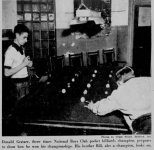I wanted to share this with ya’ll. I have been researching a Brunswick cue and a Brunswick case for some time and must express sincere thanks to Scott/runscott who has been incredibly generous with his time and knowledge.
I bought the cue and case at an estate sale after seeing a photo of the cue on estatesales.net. The cue is a first decal/second signature Brunswick Willie Hoppe Professional made of brazilian rosewood. The cue has a Hoppe ring. The case is a Brunswick “Expert Leather Cue Case” as shown on page 5 of Brunswick’s Spring 1949 Mail Order Catalog.
I have been “mining” Brunswicks catalogs and have found the following information. (I do not vouch for the accuracy of this information as I have been cautioned that information from Brunswick catalogs, etc., is not completely reliable.) Beginning in 1941, Brunswick offered the Willie Hoppe Professional in weights of 20, 21, and 22 ounces. In 1948, Brunswick added 18 and 19 ounce cues. Brunswick’s catalog gives no specifications on the length of the Willie Hoppe Professional for 1941 and 1942. In 1943 the specified length is 57 inches. In the 1945, 1946, 1948, and 1949 (Spring) catalogs, the specified length is 56 inches. In the 1949 (Fall) catalog, the length became 57 inches and remained at 57 inches for the years I checked. My cue is stamped “18” and measures 56 ⅜ inches w/o a tip. If one assumes both that Brunswick manufactured and shipped per its specifications and that my cue length is unaltered, one can fairly conclude that my cue was made in 1948 or early 1949.
As to leather cases, in 1948 Brunswick offered the “Professional” and “Aristocrat”. In 1949, the leather cases offered were “Expert” and “Aristocrat”. Brunswick continued to offer the Expert until 1954. According to the catalogs, the Professional was 35 ½ inches long and the Expert was 32 inches long. My case measures 32 inches and agrees with the Expert described and pictured in the catalog.

